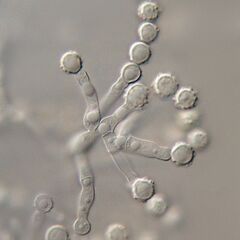Biology:Microascaceae
| Microascaceae | |
|---|---|

| |
| Scopulariopsis brevicaulis | |
| Scientific classification | |
| Script error: No such module "Taxobox ranks".: | <div style="display:inline" class="script error: no such module "taxobox ranks".">Fungi |
| Script error: No such module "Taxobox ranks".: | <div style="display:inline" class="script error: no such module "taxobox ranks".">Ascomycota |
| Script error: No such module "Taxobox ranks".: | <div style="display:inline" class="script error: no such module "taxobox ranks".">Sordariomycetes |
| Script error: No such module "Taxobox ranks".: | <div style="display:inline" class="script error: no such module "taxobox ranks".">Microascales |
| Script error: No such module "Taxobox ranks".: | <div style="display:inline" class="script error: no such module "taxobox ranks".">Microascaceae Luttr. ex Malloch (1970)
|
| Type genus | |
| Microascus Zukal (1886)
| |
The Microascaceae are a family of fungi in the class Sordariomycetes, subclass Hypocreomycetidae.[1] The family was published by David Malloch in 1970, an emended description based on Everet Stanley Luttrell's original 1951 publication.[2] Family was updated in 2020.[3]
History
It was introduced by Luttrell (1951) to accommodate genus Microascus which was originally placed in family Ophiostomataceae (Nannfeldt 1932,[4]) or Eurotiaceae in Eunotiales order, (Moreau and Moreau 1953;[5] Emmons and Dodge 1931;[6] Doguet 1957).[7] Then Malloch (1970) validated the family and accepted genera, Kernia, Lophotrichus and Petriellidium in the family.[2] Sandoval-Denis et al. (2016a,[8] b,[9]) revised Microascaceae and proposed several new taxa and combinations under Microascaceae based on multi-locus phylogenetic analysis. The last treatment of Microascaceae was provided by Hyde et al. (2020),[10] and 23 genera were accepted. Species in this family have a worldwide distribution and most species are saprobes in soil, dung or on decaying plant materials (Seifert et al. 2011;[11] de Beer et al. 2013;[12] Sandoval-Denis et al. 2016 a,[8] b;[9] Hyde et al. 2020a),[10] while a few species are opportunistic pathogens of humans (de Hoog et al. 2011;[13] Sandoval-Denis et al. 2013,[14] 2016;[8] Lackner et al. 2014).[15]
Description
Microascaceae species have spherical to irregularly shaped, darkly colored fruit bodies. They are usually hairy and rarely smooth. The smooth spores are reddish brown to copper colored, one-celled, and have a germ pore at one or both ends. Asci can occur singly or in chains.[2]
Genera
As accepted by Wijayawardene et al. 2020 (with number of species);[3]
- Acaulium Sopp (4)
- Brachyconidiellopsis Decock, R.F. Castañeda & Adhikari (1)
- Canariomyces Arx (3)
- Cephalotrichum Link (37) - anamorph
- Doratomyces Corda (3)
- Echinobotryum Corda (2)
- Enterocarpus Locq.-Lin. (2)
- Fairmania Sacc. (1)
- Gamsia M. Morelet (5)
- Kernia Nieuwl. (14)
- Lomentospora Hennebert & B.G. Desai (1)
- Lophotrichus R.K. Benj. (8)
- Microascus Zukal (60)
- Parascedosporium Gilgado, Gené, Cano & Guarro (2)
- Petriella Curzi (8)
- Pseudallescheria Negroni & I. Fisch. (8)
- Pseudoscopulariopsis Sand.-Den., Gené & Guarro (2)
- Rhinocladium Sacc. & Marchal (11)
- Scedosporium Sacc. ex Castell. & Chalm. (12)
- Scopulariopsis Bainier (87) - anamorph
- Wardomyces F.T. Brooks & Hansf. (11)
- Wardomycopsis Udagawa & Furuya (5)
- Yunnania H.Z. Kong (3)
References
- ↑ Lumbsch TH, Huhndorf SM. (December 2007). "Outline of Ascomycota – 2007". Myconet (Chicago, USA: The Field Museum, Department of Botany) 13: 1–58. Archived from the original on 2009-03-18. https://web.archive.org/web/20090318003134/http://www.fieldmuseum.org/myconet/outline.asp.
- ↑ 2.0 2.1 2.2 Malloch D. (1970). "New concepts in the Microascaceae illustrated by two species". Mycologia 62 (4): 727–40 (see p. 734). doi:10.2307/3757662. http://www.cybertruffle.org.uk/cyberliber/59350/0062/004/0734.htm.
- ↑ 3.0 3.1 Wijayawardene, Nalin; Hyde, Kevin; Al-Ani, Laith Khalil Tawfeeq; Somayeh, Dolatabadi; Stadler, Marc; Haelewaters, Danny et al. (2020). "Outline of Fungi and fungus-like taxa". Mycosphere 11: 1060–1456. doi:10.5943/mycosphere/11/1/8.
- ↑ Nannfeldt, J.A. (1932). "Studien über die Morphologie und Systematik der nichtlichenisierten inoperculaten Discomyceten.". Nova Acta Regiae Soc. Sci. Upsal. Ser. IV 8: 1–368.
- ↑ Moreau, F.; Moreau, M. (1953). "Etude du développement de quelques Aspergillacées.". Rev. Mycot. 18: 165–180.
- ↑ Emmona, C.W.; Dodge, B.O. (1931). "The ascosporic stage of species of Scopulariopsis.". Mycologia 23: 313–331.
- ↑ Doguet, G. (1957). "Organogenie du Microascus stysanophorus (Matt.) Curzi.". Bull. Soc. Mycol. France 73: 165–178.
- ↑ 8.0 8.1 8.2 Sandoval-Denis, M.; Gené, J.; Sutton, D.A.; Cano-Lira, J.F.; de Hoog, G.S.; Decock, C.A.; Wiederhold, N.P.; Guarro, J. (2016a). "Redefining Microascus, Scopulariopsis and allied genera.". Persoonia - Molecular Phylogeny and Evolution of Fungi 36: 1–36.
- ↑ 9.0 9.1 Sandoval-Denis, M.; Gené, J.; Sutton, D.A.; Wiederhold, N.P.; Cano-Lira, J.F.; Guarro, J. (2016b). "New species of Cladosporium associated with human and animal infections.". Persoonia - Molecular Phylogeny and Evolution of Fungi 36: 281.
- ↑ 10.0 10.1 Hyde, Kevin D.; Norphanphoun, C.; Maharachchikumbura, S.S.N.; Bhat, D.J.; Jones, E.B.G.; Bundhun, D.; Chen, Y.J.; Bao, D.F. et al. (2020). "Refined families of Sordariomycetes.". Mycosphere 11: 305–1059. doi:10.5943/mycosphere/11/1/7.
- ↑ Seifert, K.A.; Gams, W. (2011). "The genera of Hyphomycetes – 2011 update.". Persoonia - Molecular Phylogeny and Evolution of Fungi 27: 119–129.
- ↑ de Beer, Z.W.; Seifert, K.A.; Wingfield, M.J. (2013). "A nomenclator for ophiostomatoid genera and species in the Ophiostomatales and Microascales.". Ophiostomatoid fungi: Expanding frontiers. (12 ed.). Utrecht, CBS-KNAW Fungal Biodiversity Centre.: CBS Biodiversity Series. pp. 261–268.
- ↑ de Hoog G.S., Guarro J., Gené J., Figueras M.J. (2011) Atlas of clinical fungi. CD-ROM version 3.1. CBS-KNAW Fungal Biodiversity Centre, Utrecht, The Netherlands
- ↑ Sandoval-Denis, M.; Sutton, D.A.; Fothergill, A.W.; Cano-Lira, J.; Gené, J.; Decock, C.A.; de Hoog, G.S.; Guarro, J. (2013). "Scopulariopsis, a poorly known opportunistic fungus: 4450 spectrum of species in clinical samples and in vitro responses to antifungal drugs.". J. Clin. Microbiol. 51: 3937–3943.
- ↑ Lackner, Michaela; de Hoog, G. Sybren; Yang, Liyue; Ferreira Moreno, Leandro; Ahmed, Sarah A.; Andreas, Fritz; Kaltseis, Josef; Nagl, Markus et al. (2014-07-01). "Proposed nomenclature for Pseudallescheria, Scedosporium and related genera" (in en). Fungal Diversity 67 (1): 1–10. doi:10.1007/s13225-014-0295-4. ISSN 1878-9129.
External links
Wikidata ☰ Q6839220 entry
 |
